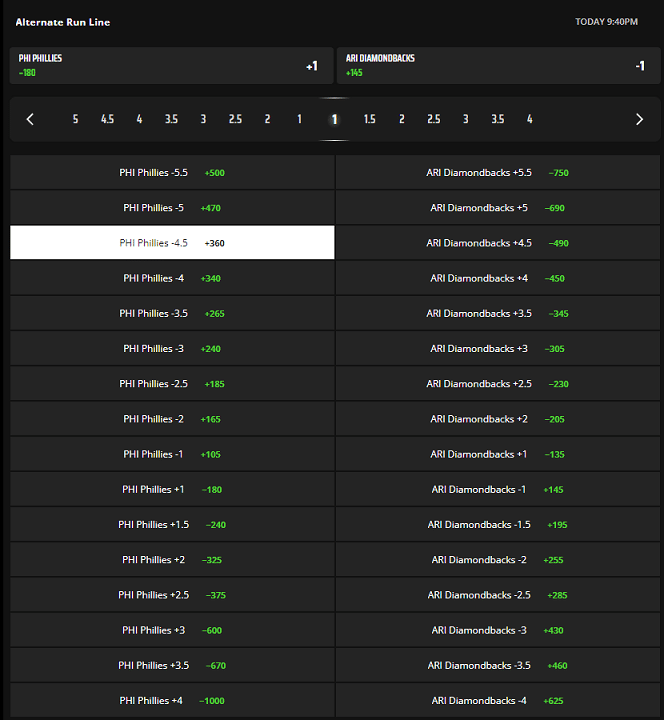A run line is a form of spread betting unique to baseball. Along with moneylines and point totals, it’s among the most popular baseball betting options at US sportsbooks.
The terminology “run line” is used for one simple reason. In baseball, there are no points, only runs. Otherwise, run lines are functionally similar to point spreads in football and basketball, with just a couple of key differences.
Run lines have a couple of appealing traits for bettors. They often allow bettors to back heavy favorites at a more reasonable price. Likewise, big underdogs aren’t such a long shot if they’re given a 1.5-run head start.
In this guide, we’ll go over how run lines work, provide examples, and detail some basic strategies that’ll help you make smarter run line wagers.
Run Line Betting Sites
 $1500 In Bonus BetsBetMGM Bonus Code: BUSABONUS
Gambling problem? Call 1-800-GAMBLER (available in the US). Call 877-8-HOPENY or text HOPENY (467369) (NY). Call 1-800-327-5050 (MA). 21+ only. Please gamble responsibly. Call 1-800-NEXT-STEP (AZ), 1-800-BETS-OFF (IA), 1-800- 981-0023 (PR). First bet offer for new customers only. Subject to eligibility requirements. Bonus bets are non-withdrawable. In partnership with Kansas Crossing Casino and Hotel. See BetMGM.com for terms. US $1500 promotional offer not available in New York, Nevada, Ontario, or Puerto Rico.
$1500 In Bonus BetsBetMGM Bonus Code: BUSABONUS
Gambling problem? Call 1-800-GAMBLER (available in the US). Call 877-8-HOPENY or text HOPENY (467369) (NY). Call 1-800-327-5050 (MA). 21+ only. Please gamble responsibly. Call 1-800-NEXT-STEP (AZ), 1-800-BETS-OFF (IA), 1-800- 981-0023 (PR). First bet offer for new customers only. Subject to eligibility requirements. Bonus bets are non-withdrawable. In partnership with Kansas Crossing Casino and Hotel. See BetMGM.com for terms. US $1500 promotional offer not available in New York, Nevada, Ontario, or Puerto Rico.
 Bet $5 Get $300FanDuel Promo Code: Not Needed
Gambling Problem? Call 1-800-GAMBLER or visit RG-Help.com. Call 1-888-789-7777 or visit ccpg.org/chat (CT). Hope is here. GamblingHelpLineMA.org or call (800) 327-5050 for 24/7 support (MA). Visit www.mdgamblinghelp.org (MD). Call 1-877-8HOPE-NY or text HOPENY (467369) (NY). 21+ (18+ D.C.) and present in select states (for KS, in affiliation with KS Star Casino). First online real money wager only. $5 first deposit required. Bonus issued as nonwithdrawable bonus bets which expire 7 days after receipt. Restrictions apply. See terms at sportsbook.fanduel.com.
Bet $5 Get $300FanDuel Promo Code: Not Needed
Gambling Problem? Call 1-800-GAMBLER or visit RG-Help.com. Call 1-888-789-7777 or visit ccpg.org/chat (CT). Hope is here. GamblingHelpLineMA.org or call (800) 327-5050 for 24/7 support (MA). Visit www.mdgamblinghelp.org (MD). Call 1-877-8HOPE-NY or text HOPENY (467369) (NY). 21+ (18+ D.C.) and present in select states (for KS, in affiliation with KS Star Casino). First online real money wager only. $5 first deposit required. Bonus issued as nonwithdrawable bonus bets which expire 7 days after receipt. Restrictions apply. See terms at sportsbook.fanduel.com.
 Up to $1000 in Bonus BetsFanatics Sportsbook Promo Code: Not Needed
Must be 21+. GAMBLING PROBLEM? Call 1-800-GAMBLER
(CO/DC/IL/KS/KY/LA/MD/OH/MI/NC/NJ/PA/TN/VA/VT/WV/WY), (800)-327-5050 or http://gamblinghelplinema.org (MA), Call (877-8-HOPENY) or text HOPENY (467369) (NY), 1-800-NEXT-STEP or text NEXTSTEP to 53342 (AZ), (888) 789-7777 or http://ccpg.org (CT), or 1-800-BETS-OFF (IA), or 1-800-9-WITH-IT (IN), or www.mdgamblinghelp.org (MD), or morethanagame.nc.gov (NC), or 1800gambler.net (WV). $1,000 No Sweat Bets offer for customers in AZ, CO, CT, DC, IA, IL, IN, KS, KY, LA, MA, MD, MI, NC, NJ, OH, PA, TN, VT, VA, WV, or WY only. Must apply this promotion in your bet slip and place a $1+ cash wager with odds of -500 or longer each day for 10 straight days. Your 10 days begin the day you establish your account. Wager must settle as a loss to qualify for Bonus Bets. Bonus Bets will equal the amount of the losing wager(s) (up to $100 in Bonus Bets per day) and expire 7 days from issuance. This offer is not available in IL, NY, & NC. Terms apply- see Fanatics Sportsbook app.
Up to $1000 in Bonus BetsFanatics Sportsbook Promo Code: Not Needed
Must be 21+. GAMBLING PROBLEM? Call 1-800-GAMBLER
(CO/DC/IL/KS/KY/LA/MD/OH/MI/NC/NJ/PA/TN/VA/VT/WV/WY), (800)-327-5050 or http://gamblinghelplinema.org (MA), Call (877-8-HOPENY) or text HOPENY (467369) (NY), 1-800-NEXT-STEP or text NEXTSTEP to 53342 (AZ), (888) 789-7777 or http://ccpg.org (CT), or 1-800-BETS-OFF (IA), or 1-800-9-WITH-IT (IN), or www.mdgamblinghelp.org (MD), or morethanagame.nc.gov (NC), or 1800gambler.net (WV). $1,000 No Sweat Bets offer for customers in AZ, CO, CT, DC, IA, IL, IN, KS, KY, LA, MA, MD, MI, NC, NJ, OH, PA, TN, VT, VA, WV, or WY only. Must apply this promotion in your bet slip and place a $1+ cash wager with odds of -500 or longer each day for 10 straight days. Your 10 days begin the day you establish your account. Wager must settle as a loss to qualify for Bonus Bets. Bonus Bets will equal the amount of the losing wager(s) (up to $100 in Bonus Bets per day) and expire 7 days from issuance. This offer is not available in IL, NY, & NC. Terms apply- see Fanatics Sportsbook app.
 Bet $5 Get $100Bet365 Bonus Code: BETUSAGAMBLING PROBLEM? CALL OR TEXT 1-800-GAMBLER (AZ, CO, IL, IN, KY, LA, NC, NJ, OH, PA, VA), 1-800-BETS OFF (IA) or 1-800-889-9789 (TN). 21+ only (18+ in KY). Must be present in AZ/CO/IA/IL/IN/KY/LA (select parishes)/NC/NJ/OH/PA/TN/VA. New Customer Offer Bet $5 and Get $100 in Bonus Bets at bet365. *Subject to meeting qualifying criteria. Minimum wager $5. Minimum odds -500 or greater. $10 minimum deposit. Paid in Bonus Bets. Bonus Bets wager excluded from returns. New customers only. Available in app only, time restrictions and T&Cs apply.
Bet $5 Get $100Bet365 Bonus Code: BETUSAGAMBLING PROBLEM? CALL OR TEXT 1-800-GAMBLER (AZ, CO, IL, IN, KY, LA, NC, NJ, OH, PA, VA), 1-800-BETS OFF (IA) or 1-800-889-9789 (TN). 21+ only (18+ in KY). Must be present in AZ/CO/IA/IL/IN/KY/LA (select parishes)/NC/NJ/OH/PA/TN/VA. New Customer Offer Bet $5 and Get $100 in Bonus Bets at bet365. *Subject to meeting qualifying criteria. Minimum wager $5. Minimum odds -500 or greater. $10 minimum deposit. Paid in Bonus Bets. Bonus Bets wager excluded from returns. New customers only. Available in app only, time restrictions and T&Cs apply.21+ to Play, T&Cs Apply. Gambling Problem? Call 1-800-GAMBLER
What is a Run Line Bet in Baseball?
For all baseball games, whether they be MLB playoff or South Korean KBO games, the run line is featured as a primary bet. Here is how the Caesars Sportsbook app displays run lines, sandwiched between the moneyline and the total:
Like all spread bets, run line baseball bets consist of two components.
The first is the odds (shown in green above), with negative numbers indicating favorites and positive numbers representing underdogs.
The larger the negative number, the bigger the favorite. Likewise, a large positive number signals a heavy underdog. US sportsbooks use American Odds exclusively as their primary odds format.
The second number is the spread. Unlike NFL point spreads, run lines are not equalizers. In the NFL, the underdog “gets” a number of points, and the favorite “gives” the same number of points to effectively make the game a coin flip. That’s why most NFL point spreads offer -110 odds on both sides. This represents a 50/50 outcome after factoring in vigorish.
Instead, run line bets use the following rules:
- The favorite “gives” 1.5 runs (-1.5), meaning that they’ll have to win by 2+ runs for the bet to cash.
- The underdog “gets” 1.5 runs (+1.5). The run line bet cashes if the underdog wins or loses by one run.
The run line spread is kept intentionally small because baseball games are low scoring and not highly variable. Baseball also doesn’t rely on key numbers like football.
There are instances when the pre-game run line is 2.5 or even 3.5, but they’re somewhat rare. Even rarer are occasions when the run line doesn’t end in .5. The .5 prevents run line wagers from ever ending in a push.
The impact of a run line depends on the scenario:
- A favorite will either become less of a favorite or a small underdog.
- An underdog will either become less of a long shot or a small favorite.
- If the teams are evenly matched, the run line will make one team a moderate favorite and the other a moderate dog.
Run Line Example
Let’s see how a run line impacts the moneyline odds. Here is a recent example from DraftKings Sportsbook:

At -170 moneyline odds, the Tampa Bay Rays are rather heavy favorites, with 63% implied odds to win. However, when they give +1.5 runs to the Rangers, they’re suddenly +120 dogs. This is a mammoth .90-cent shift and brings the Rays’ implied odds down to 45.5%.
Likewise, the Rangers go from +145 underdogs to -140 favorites, a .85 cent differential.
There are only two scenarios where a moneyline cashes but a run line wager on the same team doesn’t:
- For favorites: The moneyline bet wins and the run line loses when the favorite wins by exactly one run.
- For underdogs: The moneyline bet cashes and the run line bet loses when the team loses by one run.
Given this, the difference in odds between moneyline and run line odds may seem too drastic. However, history shows that approximately 28% of MLB games end with a one-run differential.
Note: One reason why there are so many one run games in baseball is that if the home team is winning by one after 8.5 innings, the bottom of the ninth isn’t played.
Interestingly, baseball isn’t the only sport where the run line rule is applied. Hockey betting uses a similar 1.5 spread, except it’s called the puck line. The difference between the two is really in name only, although in hockey the puck line has an even greater impact on the moneyline odds because it’s such a low scoring sport.
Types of Run Line Bets
Most US sportsbooks have greatly increased their betting menu, now offering a nearly endless array of alternative spreads, derivatives, props, and futures.
It follows that there are a variety of run line variations. Here’s a glance at just a few:
- 1st five innings: This wager is graded after five complete innings have been played.
- Inning run line: Several US sportsbooks, like FanDuel Sportsbook, support single-inning run line wagers. What’s important to note here is that the wager only applies to the inning selected. Runs scored in any other inning do not factor in. For instance, if Tampa Bay is winning 6-3 after the sixth, and a bettor places a 7th inning run line wager on them at -1.5, they’ll have to score two more runs than their opponent in the 7th for the bet to cash.
- Alternative run lines: Just as there are alternative point spreads in football, there are alt run lines in baseball. At most sports betting sites, bettors can place run line bets at 1-run increments ranging from at least -3.5 to +3.5. Bettors who really want to get fancy can place alternative run line wagers on the first five innings.
- Live run line betting: Run line wagers don’t magically disappear after the first pitch is thrown. In-game run line wagers are an exceedingly popular bet, with the odds often changing after every pitch.
With live run betting, the +1.5/-1.5 often breaks down. If one team jumps out to a big lead, it may change to +2.5/-2.5 or even +3.5/-3.5. This ensures that the bet remains appealing to bettors, even in early blowouts.
How to Place a Run Line Bet
Most online sportsbooks list run line bets front and center, making them easy to locate. Take the following simple steps from either your desktop or mobile betting app to find the day’s run line betting markets:
- Log in to your online sports wagering account
- Navigate to the baseball betting market
- (Optional) Select the league: MLB, NCAA, KBO etc.
- Run line bets will be displayed for each game. Sometimes they’re called spreads, but it’s effectively the same thing. Games are usually displayed in time order, starting with games that are already in progress.
- Find a bet that you like, then click or tap on it to add it to your bet slip.
- Input the amount you’d like to wager, and either confirm the bet, save it for later, or add more wagers to convert the bet into a parlay.
Baseball bettors may have to dig a bit deeper to find alternative run lines. These can typically be found by clicking into a game and then navigating to the alt lines submenu. Here is what an alternative run line betting menu looks like on DraftKings:
Notice that DraftKings is extra generous with its alternative run lines, offering spreads ranging from -5.5 to +5.5, including half-runs.
Calculating the Juice on Run Line Bets
The process for evaluating a run line bet is the same as for a moneyline:
- Calculate the implied odds for both sides. For a quick primer on how to do that, visit BettingUSA’s vigorish page.
- Add the two together. The result should be slightly over 100%. Subtract 100% from the sum to get the overround.
- Divide the overround by the sum of the implied odds. That’s the house edge.
As an example, suppose a sportsbook offers the following run line bet:
- New York Yankees -1.5: +160
- Boston Red Sox +1.5: -190
The implied odds of the Yankees winning by 2 or more runs is 38.46%. Alternatively, the implied odds of the Red Sox winning or losing by one is 65.52%.
The sum of implied odds is 38.46% + 65.52% = 103.98%. Subtract 100% to get the overround, which is 3.98%.
Now divide the overround by the sum of implied odds. That yields 3.98/103.98 = 0.03828, or 3.828%. This figure represents the juice, and it’s what the house expects to make assuming even money on both sides.
In-game vig tends to be a little higher than pre-game. There are multiple reasons behind this, but suffice it to say, that in-game lines tend to be less accurate, so sportsbooks compensate by providing themselves with extra cushion.
Run Line vs. Moneyline: Which is Better?
Are baseball fans better off placing moneyline or run line wagers? Ultimately, it depends on where they’re betting.
BettingUSA has conducted an analysis of four major sportsbooks and came up with the following results:
| Sportsbook | Moneyline Vig % | Runline Vig % |
|---|---|---|
| Caesars Sportsbook | 4.12% | 4.05% |
| DraftKings Sportsbook | 3.88% | 3.79% |
| FanDuel Sportsbook | 3.91% | 4.38% |
| BetMGM Sportsbook | 4.61% | 4.15% |
Notice that each book handles vig slightly differently:
- DraftKings and Caesars charge about the same tax on run line and moneyline wagers. However, the overall vig is lower on DraftKings. In fact, it’s lower than on nearly every US sportsbook.
- FanDuel juices up its run line bets by nearly 0.5% compared to its moneylines.
- BetMGM gives run line bettors a moderate discount.
Of course, these figures only represent averages, but they give an idea of how sportbooks approach run line pricing. They also dispel the myth that run lines are always more expensive than moneylines.
One interesting note: On most sportsbooks, bets where the odds reflect a big favorite/heavy underdog tend to have lower vig, regardless of whether it’s a moneyline or run line wager. The exception was BetMGM Sportsbook.
Run Line Betting Tips
Sadly, both MLB run lines and moneyline wagers are usually pretty sharp. Bettors can find edges, but they’re scarce.
However, there are ways to consistently minimize the house edge in run line bets, and even eliminate it, by following some simple advice:
- Always shop around: A bettor with just one betting app is like a catcher without a glove. Line shopping empowers bettors to find the best possible line.
- Bet alternative run lines: It’s easier to find value betting alternative spreads, as these wagers get less volume and aren’t always hammered perfectly into place by game time.
- Be wary of 1st five inning spreads: The first few innings of a baseball game are a bit easier for bookmakers to predict than the entire game. This is because teams don’t turn to their relievers or shake up their lineups until later in the ballgame, with some exceptions.
- Place in-game wagers, sometimes: There’s no denying that in-game pricing is worse than its pre-game counterpart. For in-game run line bets, the house edge may run as high as 6-7%. However, the live lines from book to book are more variable, opening up opportunities for bettors to snipe stale lines or overly aggressive line changes. Just don’t do this too often, or the book will catch on and limit your wagers.
- Make use of promotions: Sports betting promotions that offer value to run line bettors are worth considering. For instance, if a book offers a $10 bonus bet to bettors who place a $25 run line wager, the expected value flips from negative to positive.
- Bet smaller markets: The MLB is obviously a major market in the United States, and games get a lot of betting volume. It follows that MLB lines are extremely sharp, sometimes too sharp to overcome. However, smaller markets like the NCAA and Korean leagues aren’t bet as heavily. It may be easier to find edges.
Serious bettors are also advised to keep up with injury reports and to follow baseball beat writers on social media. Knowing when a team’s lineup is going to be announced is also a valuable asset.
If you aspire to create a baseball model, start with your favorite team, or the team you know the best. Then move on to teams in the same division, and so forth.
Run Line Betting FAQ
Robert Dellafave is an expert sports bettor, professional gambler, and advocate for the fair treatment of sports bettors.


